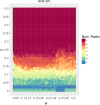Modeling confirmation bias and polarization
- PMID: 28074874
- PMCID: PMC5225437
- DOI: 10.1038/srep40391
Modeling confirmation bias and polarization
Abstract
Online users tend to select claims that adhere to their system of beliefs and to ignore dissenting information. Confirmation bias, indeed, plays a pivotal role in viral phenomena. Furthermore, the wide availability of content on the web fosters the aggregation of likeminded people where debates tend to enforce group polarization. Such a configuration might alter the public debate and thus the formation of the public opinion. In this paper we provide a mathematical model to study online social debates and the related polarization dynamics. We assume the basic updating rule of the Bounded Confidence Model (BCM) and we develop two variations a) the Rewire with Bounded Confidence Model (RBCM), in which discordant links are broken until convergence is reached; and b) the Unbounded Confidence Model, under which the interaction among discordant pairs of users is allowed even with a negative feedback, either with the rewiring step (RUCM) or without it (UCM). From numerical simulations we find that the new models (UCM and RUCM), unlike the BCM, are able to explain the coexistence of two stable final opinions, often observed in reality. Lastly, we present a mean field approximation of the newly introduced models.
Figures




References
-
- Quattrociocchi W., Scala A. & Sunstein C. R. Echo chambers on facebook. Available at SSRN, https://ssrn.com/abstract=2795110 (2016).
-
- Bessi A. et al.. Viral misinformation: The role of homophily and polarization. In Proceedings of the 24th International Conference on World Wide Web Companion, 355–356 (International World Wide Web Conferences Steering Committee, 2015).
-
- Zollo F. et al.. Debunking in a world of tribes URL http://arxiv.org/abs/1510.04267 (2015). - PubMed
-
- Jøsang A., Quattrociocchi W. & Karabeg D. Taste and trust. In IFIP International Conference on Trust Management, 312–322 (Springer, 2011).
Publication types
MeSH terms
LinkOut - more resources
Full Text Sources
Other Literature Sources
Research Materials

